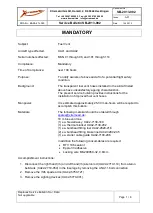
Pilot Operating Handbook
Cavalon
SECTION 3
EMERGENCY PROCEDURES
AutoGyro_POH_Cavalon 915iS
Revision 1.0 – Issue Date 08.MAY.2019
3-2
Select a suitable landing site – the landing lights make the ground visible in full dark
from around 400ft
If time allows, a restart may be attempted, see “Air restart procedure” below
Perform a landing into wind and/or upslope if possible
Make a faster descent at 70mph (~60KIAS, 120kmh), to allow more time in the flare
to make a safe landing.
Do not turn the main switch off, because this will turn off all lighting. Be prepared to
turn the switch off if there is a risk of an accident.
WARNING
Engine failure at high speed, hands-off, will result in a nose drop, requiring
pilot intervention to raise the nose. At light weight the nose drop will be rapid.
WARNING
Always plan your route to remain within safe gliding distance to areas where a
safe forced landing can be performed in case of an engine failure. A landing in
high trees or open waters may end with a serious accident.
NOTE
The best engine-off glide ratio is about 1:3 at 90 km/h (55-60mph, 50KIAS).
Depending on a possible headwind the glide may be extended by slightly
increasing airspeed. It is heavily recommended to train your forced landing
capabilities regularly, preferably with a qualified flight instructor.
3.2
Air Restart Procedure
Check fuel valve OPEN
Check fuel pump(s) ON
Check both LANE switches ON
Throttle slightly open
With the left hand, turn the Main Switch/Starter key completely to OFF, then ON
WAIT until the Lane A and B leds are illuminated before turning to START, otherwise
the engine may not start!
If possible, allow engine and oil to warm-up before full power is applied
NOTE
The starter interlock function prevents inadvertent starter engagement. Before
attempting an engine start, the interlock must be reset by turning the Main
Switch/Starter key to OFF.
















































